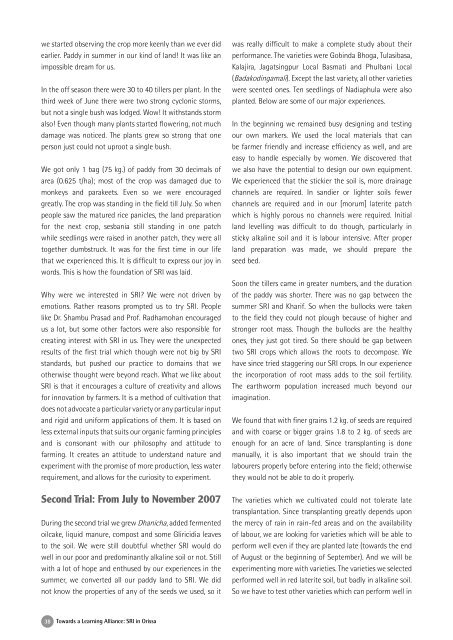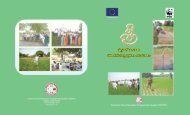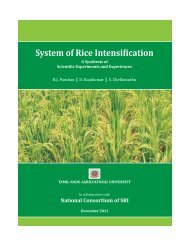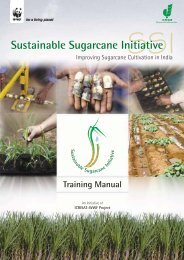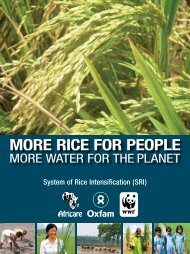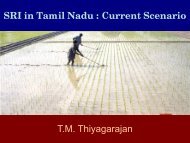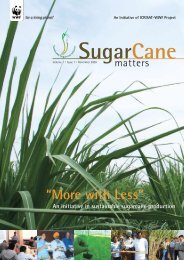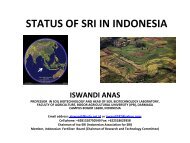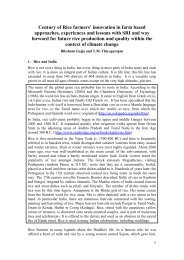SRI in Orissa - Cornell International Institute for Food, Agriculture ...
SRI in Orissa - Cornell International Institute for Food, Agriculture ...
SRI in Orissa - Cornell International Institute for Food, Agriculture ...
You also want an ePaper? Increase the reach of your titles
YUMPU automatically turns print PDFs into web optimized ePapers that Google loves.
we started observ<strong>in</strong>g the crop more keenly than we ever did<br />
earlier. Paddy <strong>in</strong> summer <strong>in</strong> our k<strong>in</strong>d of land! It was like an<br />
impossible dream <strong>for</strong> us.<br />
In the off season there were 30 to 40 tillers per plant. In the<br />
third week of June there were two strong cyclonic storms,<br />
but not a s<strong>in</strong>gle bush was lodged. Wow! It withstands storm<br />
also! Even though many plants started flower<strong>in</strong>g, not much<br />
damage was noticed. The plants grew so strong that one<br />
person just could not uproot a s<strong>in</strong>gle bush.<br />
We got only 1 bag (75 kg.) of paddy from 30 decimals of<br />
area (0.625 t/ha); most of the crop was damaged due to<br />
monkeys and parakeets. Even so we were encouraged<br />
greatly. The crop was stand<strong>in</strong>g <strong>in</strong> the field till July. So when<br />
people saw the matured rice panicles, the land preparation<br />
<strong>for</strong> the next crop, sesbania still stand<strong>in</strong>g <strong>in</strong> one patch<br />
while seedl<strong>in</strong>gs were raised <strong>in</strong> another patch, they were all<br />
together dumbstruck. It was <strong>for</strong> the first time <strong>in</strong> our life<br />
that we experienced this. It is difficult to express our joy <strong>in</strong><br />
words. This is how the foundation of <strong>SRI</strong> was laid.<br />
Why were we <strong>in</strong>terested <strong>in</strong> <strong>SRI</strong>? We were not driven by<br />
emotions. Rather reasons prompted us to try <strong>SRI</strong>. People<br />
like Dr. Shambu Prasad and Prof. Radhamohan encouraged<br />
us a lot, but some other factors were also responsible <strong>for</strong><br />
creat<strong>in</strong>g <strong>in</strong>terest with <strong>SRI</strong> <strong>in</strong> us. They were the unexpected<br />
results of the first trial which though were not big by <strong>SRI</strong><br />
standards, but pushed our practice to doma<strong>in</strong>s that we<br />
otherwise thought were beyond reach. What we like about<br />
<strong>SRI</strong> is that it encourages a culture of creativity and allows<br />
<strong>for</strong> <strong>in</strong>novation by farmers. It is a method of cultivation that<br />
does not advocate a particular variety or any particular <strong>in</strong>put<br />
and rigid and uni<strong>for</strong>m applications of them. It is based on<br />
less external <strong>in</strong>puts that suits our organic farm<strong>in</strong>g pr<strong>in</strong>ciples<br />
and is consonant with our philosophy and attitude to<br />
farm<strong>in</strong>g. It creates an attitude to understand nature and<br />
experiment with the promise of more production, less water<br />
requirement, and allows <strong>for</strong> the curiosity to experiment.<br />
Second Trial: From July to November 2007<br />
Dur<strong>in</strong>g the second trial we grew Dhanicha, added fermented<br />
oilcake, liquid manure, compost and some Gliricidia leaves<br />
to the soil. We were still doubtful whether <strong>SRI</strong> would do<br />
well <strong>in</strong> our poor and predom<strong>in</strong>antly alkal<strong>in</strong>e soil or not. Still<br />
with a lot of hope and enthused by our experiences <strong>in</strong> the<br />
summer, we converted all our paddy land to <strong>SRI</strong>. We did<br />
not know the properties of any of the seeds we used, so it<br />
was really difficult to make a complete study about their<br />
per<strong>for</strong>mance. The varieties were Gob<strong>in</strong>da Bhoga, Tulasibasa,<br />
Kalajira, Jagats<strong>in</strong>gpur Local Basmati and Phulbani Local<br />
(Badakod<strong>in</strong>gamali). Except the last variety, all other varieties<br />
were scented ones. Ten seedl<strong>in</strong>gs of Nadiaphula were also<br />
planted. Below are some of our major experiences.<br />
In the beg<strong>in</strong>n<strong>in</strong>g we rema<strong>in</strong>ed busy design<strong>in</strong>g and test<strong>in</strong>g<br />
our own markers. We used the local materials that can<br />
be farmer friendly and <strong>in</strong>crease efficiency as well, and are<br />
easy to handle especially by women. We discovered that<br />
we also have the potential to design our own equipment.<br />
We experienced that the stickier the soil is, more dra<strong>in</strong>age<br />
channels are required. In sandier or lighter soils fewer<br />
channels are required and <strong>in</strong> our [morum] laterite patch<br />
which is highly porous no channels were required. Initial<br />
land levell<strong>in</strong>g was difficult to do though, particularly <strong>in</strong><br />
sticky alkal<strong>in</strong>e soil and it is labour <strong>in</strong>tensive. After proper<br />
land preparation was made, we should prepare the<br />
seed bed.<br />
Soon the tillers came <strong>in</strong> greater numbers, and the duration<br />
of the paddy was shorter. There was no gap between the<br />
summer <strong>SRI</strong> and Kharif. So when the bullocks were taken<br />
to the field they could not plough because of higher and<br />
stronger root mass. Though the bullocks are the healthy<br />
ones, they just got tired. So there should be gap between<br />
two <strong>SRI</strong> crops which allows the roots to decompose. We<br />
have s<strong>in</strong>ce tried stagger<strong>in</strong>g our <strong>SRI</strong> crops. In our experience<br />
the <strong>in</strong>corporation of root mass adds to the soil fertility.<br />
The earthworm population <strong>in</strong>creased much beyond our<br />
imag<strong>in</strong>ation.<br />
We found that with f<strong>in</strong>er gra<strong>in</strong>s 1.2 kg. of seeds are required<br />
and with coarse or bigger gra<strong>in</strong>s 1.8 to 2 kg. of seeds are<br />
enough <strong>for</strong> an acre of land. S<strong>in</strong>ce transplant<strong>in</strong>g is done<br />
manually, it is also important that we should tra<strong>in</strong> the<br />
labourers properly be<strong>for</strong>e enter<strong>in</strong>g <strong>in</strong>to the field; otherwise<br />
they would not be able to do it properly.<br />
The varieties which we cultivated could not tolerate late<br />
transplantation. S<strong>in</strong>ce transplant<strong>in</strong>g greatly depends upon<br />
the mercy of ra<strong>in</strong> <strong>in</strong> ra<strong>in</strong>-fed areas and on the availability<br />
of labour, we are look<strong>in</strong>g <strong>for</strong> varieties which will be able to<br />
per<strong>for</strong>m well even if they are planted late (towards the end<br />
of August or the beg<strong>in</strong>n<strong>in</strong>g of September). And we will be<br />
experiment<strong>in</strong>g more with varieties. The varieties we selected<br />
per<strong>for</strong>med well <strong>in</strong> red laterite soil, but badly <strong>in</strong> alkal<strong>in</strong>e soil.<br />
So we have to test other varieties which can per<strong>for</strong>m well <strong>in</strong><br />
38<br />
Towards a Learn<strong>in</strong>g Alliance: <strong>SRI</strong> <strong>in</strong> <strong>Orissa</strong>


